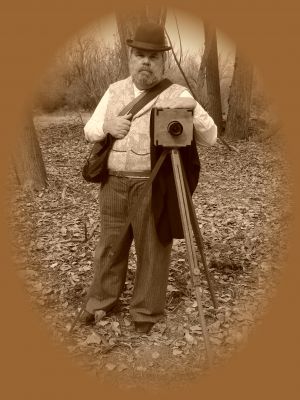The $45 Baker Tent (the first of several Penny-pinching Outfitting Stories)

You can't be around the reenacting
scene for very long before you start to realize, "Dang! This stuff can get awful expensive!" $250 for a uniform, $500+ for a long gun, $100 for a pair of stiff, pain-inflicting, blister-inducing brogans (you can buy a pair of nice, ergonomically pleasant
Clarks for that kind of money!); and that's just the beginning. There's personal gear, camp gear, battle gear, and various and sundry accessories that no self-respecting reenactor could
possibly do without.
As was the case in the middle 1800s, the sutlers pretty much have us by the short ones. To be fair, they generally produce a good product at a somewhat reasonable Twenty-first Century price (except the brogans!). But for anyone inclined to make some of his or her own gear, it's kinda irritating that only the sutlers seem to know how to get their hands on period-correct 'raw' materials needed to produce the things reenactors need (and want).

The
$45 Baker Tent has its origins in the
$8 Infantry Blanket Incident. Let me explain. A post to one of the reenactor mailing lists pointed out that a cheap, mostly wool gray blanket sold by
Harbor Freight makes a reasonably good stand-in for the cheap, mostly wool gray blanket once issued by the U.S. Army. Better still, if $8 was still too rich for the blood, one need only wait for the inevitable sale that would knock a couple of bucks off the price.
The
$8 Infantry Blanket Incident reminded me that acceptable, non-traditional, inexpensive options occasionally do turn up; it’s just a matter of being observant and remaining alert to the possibilities.
Once I realized it would be handy and somewhat plausible to have a portable portrait ‘studio’ to take into the wilderness, my thoughts immediately turned to the versatile Baker Tent. As you can see from the illustration above, this type of tent has a large entrance covered by a draping flap that, with the addition of a pair of poles and two lines, doubles as an awning. Sutler prices for an ‘authentic’ Baker start at around $400 and go up from there.
A short historical interlude about the Baker Tent: Some folks believe that the design has its roots in World War I and the name stems from its supposed use as a shelter in which army cooks baked bread. But knowledgeable researchers generally agree that the design is much older than that; from written descriptions it appears that the Baker Tent goes back to at least the time of the Napoleonic Wars (1803-1815). As for the name, it seems generally accepted that ‘baker’ refers to the tent’s similarity in shape to the traditional reflector oven, used to bake bread goods next to the cooking fire using reflected heat.
More in the next post....








